Bert Wang-Chak Chan
Flowers
Flow-Lenia: Emergent evolutionary dynamics in mass conservative continuous cellular automata
Jun 10, 2025Abstract:Central to the artificial life endeavour is the creation of artificial systems spontaneously generating properties found in the living world such as autopoiesis, self-replication, evolution and open-endedness. While numerous models and paradigms have been proposed, cellular automata (CA) have taken a very important place in the field notably as they enable the study of phenomenons like self-reproduction and autopoiesis. Continuous CA like Lenia have been showed to produce life-like patterns reminiscent, on an aesthetic and ontological point of view, of biological organisms we call creatures. We propose in this paper Flow-Lenia, a mass conservative extension of Lenia. We present experiments demonstrating its effectiveness in generating spatially-localized patters (SLPs) with complex behaviors and show that the update rule parameters can be optimized to generate complex creatures showing behaviors of interest. Furthermore, we show that Flow-Lenia allows us to embed the parameters of the model, defining the properties of the emerging patterns, within its own dynamics thus allowing for multispecies simulations. By using the evolutionary activity framework as well as other metrics, we shed light on the emergent evolutionary dynamics taking place in this system.
* This manuscript has been accepted for publication in the Artificial Life journal (https://direct.mit.edu/artl)
Discovering Sensorimotor Agency in Cellular Automata using Diversity Search
Feb 14, 2024
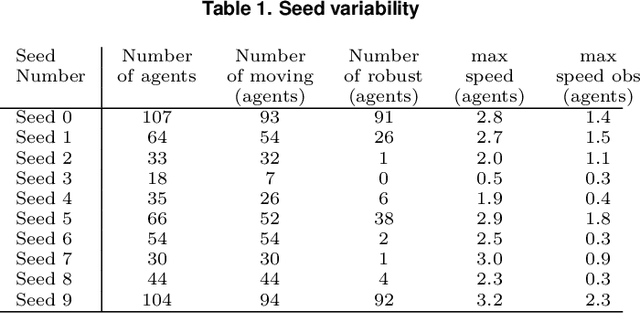
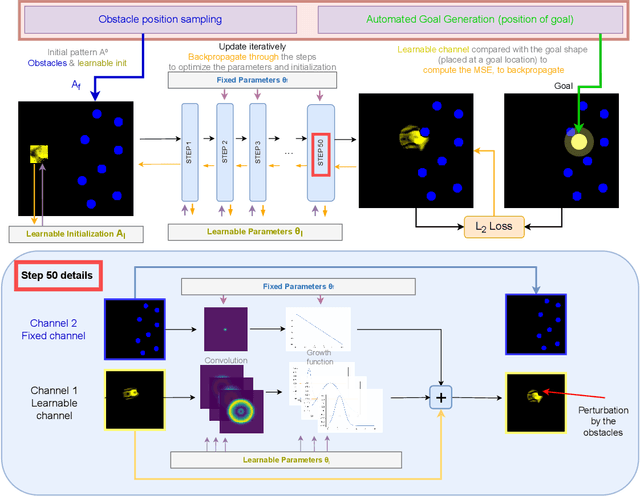
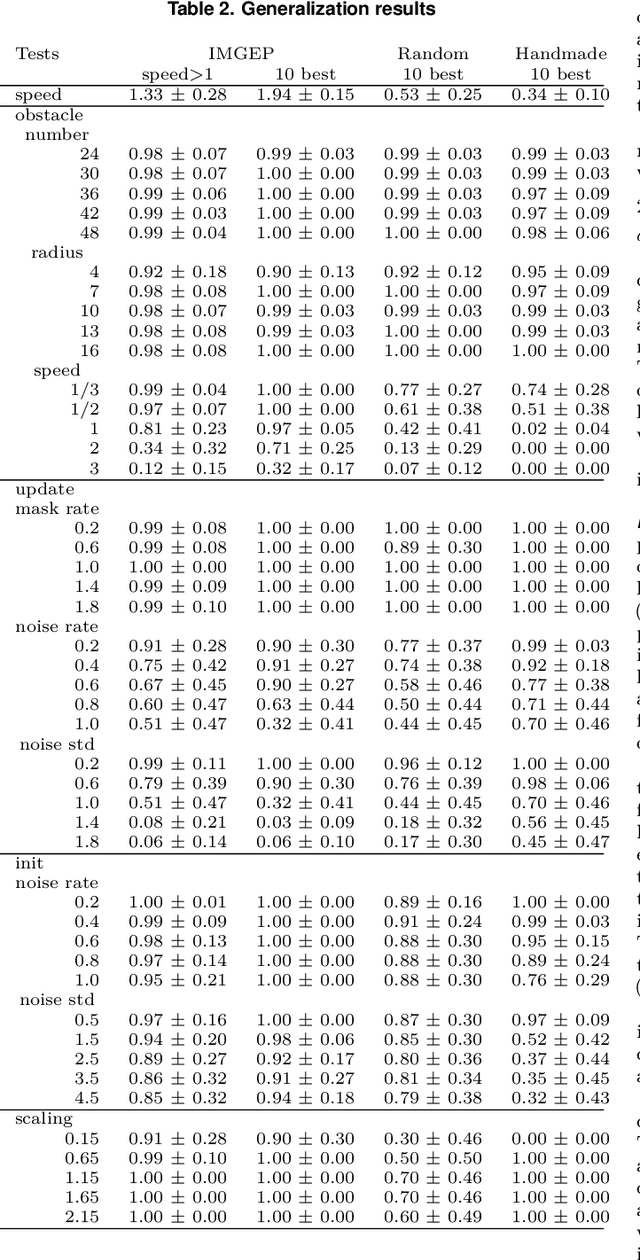
Abstract:The research field of Artificial Life studies how life-like phenomena such as autopoiesis, agency, or self-regulation can self-organize in computer simulations. In cellular automata (CA), a key open-question has been whether it it is possible to find environment rules that self-organize robust "individuals" from an initial state with no prior existence of things like "bodies", "brain", "perception" or "action". In this paper, we leverage recent advances in machine learning, combining algorithms for diversity search, curriculum learning and gradient descent, to automate the search of such "individuals", i.e. localized structures that move around with the ability to react in a coherent manner to external obstacles and maintain their integrity, hence primitive forms of sensorimotor agency. We show that this approach enables to find systematically environmental conditions in CA leading to self-organization of such basic forms of agency. Through multiple experiments, we show that the discovered agents have surprisingly robust capabilities to move, maintain their body integrity and navigate among various obstacles. They also show strong generalization abilities, with robustness to changes of scale, random updates or perturbations from the environment not seen during training. We discuss how this approach opens new perspectives in AI and synthetic bioengineering.
Meta-Diversity Search in Complex Systems, A Recipe for Artificial Open-Endedness ?
Dec 01, 2023Abstract:Can we build an artificial system that would be able to generate endless surprises if ran "forever" in Minecraft? While there is not a single path toward solving that grand challenge, this article presents what we believe to be some working ingredients for the endless generation of novel increasingly complex artifacts in Minecraft. Our framework for an open-ended system includes two components: a complex system used to recursively grow and complexify artifacts over time, and a discovery algorithm that leverages the concept of meta-diversity search. Since complex systems have shown to enable the emergence of considerable complexity from set of simple rules, we believe them to be great candidates to generate all sort of artifacts in Minecraft. Yet, the space of possible artifacts that can be generated by these systems is often unknown, challenging to characterize and explore. Therefore automating the long-term discovery of novel and increasingly complex artifacts in these systems is an exciting research field. To approach these challenges, we formulate the problem of meta-diversity search where an artificial "discovery assistant" incrementally learns a diverse set of representations to characterize behaviors and searches to discover diverse patterns within each of them. A successful discovery assistant should continuously seek for novel sources of diversities while being able to quickly specialize the search toward a new unknown type of diversity. To implement those ideas in the Minecraft environment, we simulate an artificial "chemistry" system based on Lenia continuous cellular automaton for generating artifacts, as well as an artificial "discovery assistant" (called Holmes) for the artifact-discovery process. Holmes incrementally learns a hierarchy of modular representations to characterize divergent sources of diversity and uses a goal-based intrinsically-motivated exploration as the diversity search strategy.
Towards Large-Scale Simulations of Open-Ended Evolution in Continuous Cellular Automata
Apr 12, 2023Abstract:Inspired by biological and cultural evolution, there have been many attempts to explore and elucidate the necessary conditions for open-endedness in artificial intelligence and artificial life. Using a continuous cellular automata called Lenia as the base system, we built large-scale evolutionary simulations using parallel computing framework JAX, in order to achieve the goal of never-ending evolution of self-organizing patterns. We report a number of system design choices, including (1) implicit implementation of genetic operators, such as reproduction by pattern self-replication, and selection by differential existential success; (2) localization of genetic information; and (3) algorithms for dynamically maintenance of the localized genotypes and translation to phenotypes. Simulation results tend to go through a phase of diversity and creativity, gradually converge to domination by fast expanding patterns, presumably a optimal solution under the current design. Based on our experimentation, we propose several factors that may further facilitate open-ended evolution, such as virtual environment design, mass conservation, and energy constraints.
Flow Lenia: Mass conservation for the study of virtual creatures in continuous cellular automata
Dec 14, 2022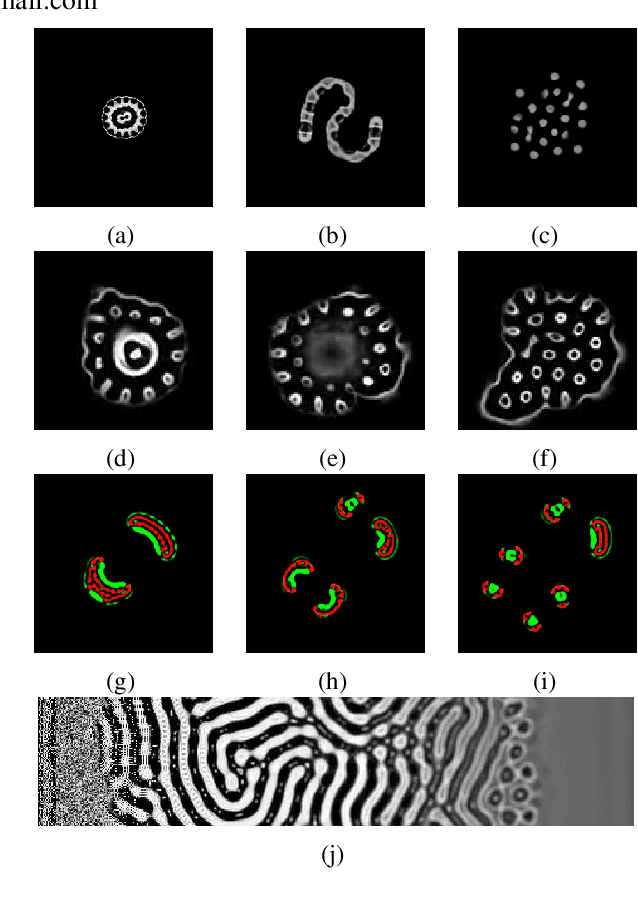
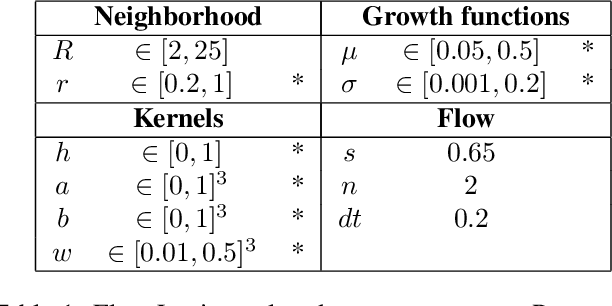
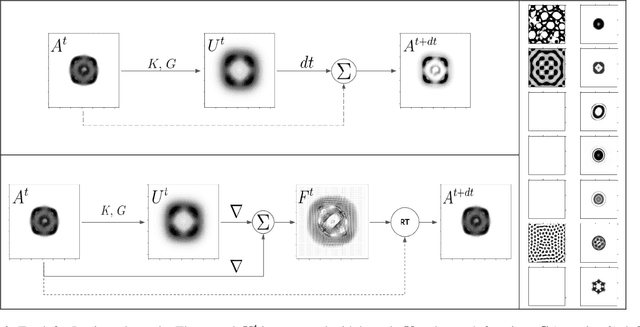
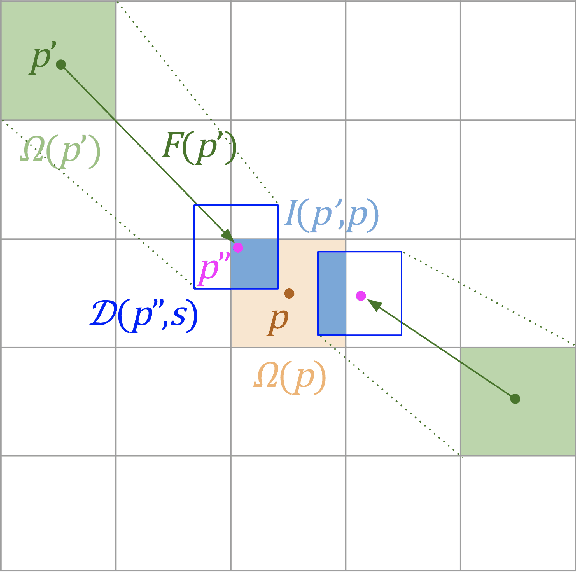
Abstract:Lenia is a family of cellular automata (CA) generalizing Conway's Game of Life to continuous space, time and states. Lenia has attracted a lot of attention because of the wide diversity of self-organizing patterns it can generate. Among those, some spatially localized patterns (SLPs) resemble life-like artificial creatures. However, those creatures are found in only a small subspace of the Lenia parameter space and are not trivial to discover, necessitating advanced search algorithms. We hypothesize that adding a mass conservation constraint could facilitate the emergence of SLPs. We propose here an extension of the Lenia model, called Flow Lenia, which enables mass conservation. We show a few observations demonstrating its effectiveness in generating SLPs with complex behaviors. Furthermore, we show how Flow Lenia enables the integration of the parameters of the CA update rules within the CA dynamics, making them dynamic and localized. This allows for multi-species simulations, with locally coherent update rules that define properties of the emerging creatures, and that can be mixed with neighbouring rules. We argue that this paves the way for the intrinsic evolution of self-organized artificial life forms within continuous CAs.
Lenia and Expanded Universe
May 07, 2020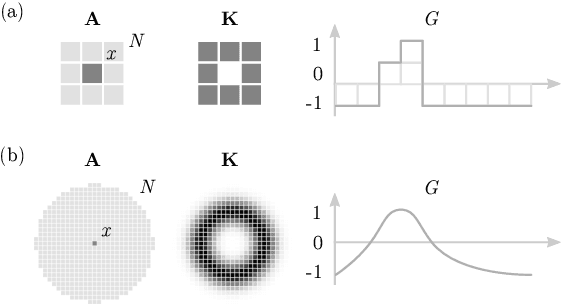
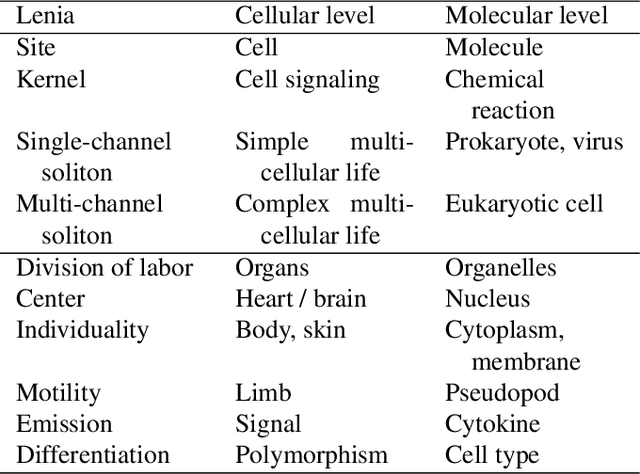
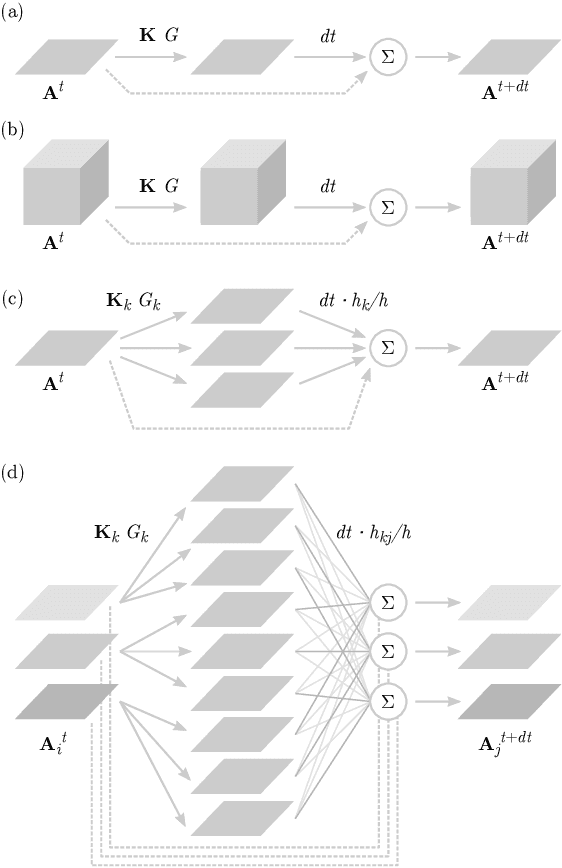

Abstract:We report experimental extensions of Lenia, a continuous cellular automata family capable of producing lifelike self-organizing autonomous patterns. The rule of Lenia was generalized into higher dimensions, multiple kernels, and multiple channels. The final architecture approaches what can be seen as a recurrent convolutional neural network. Using semi-automatic search e.g. genetic algorithm, we discovered new phenomena like polyhedral symmetries, individuality, self-replication, emission, growth by ingestion, and saw the emergence of "virtual eukaryotes" that possess internal division of labor and type differentiation. We discuss the results in the contexts of biology, artificial life, and artificial intelligence.
Lenia - Biology of Artificial Life
Dec 21, 2018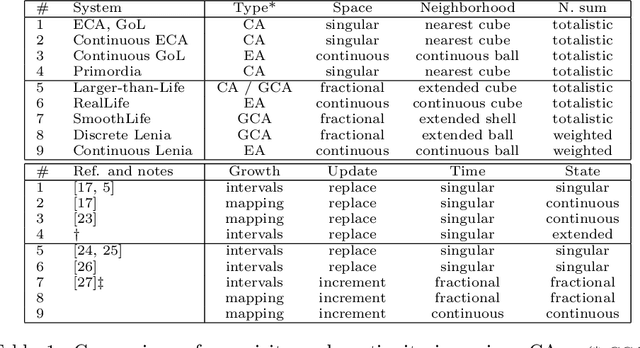
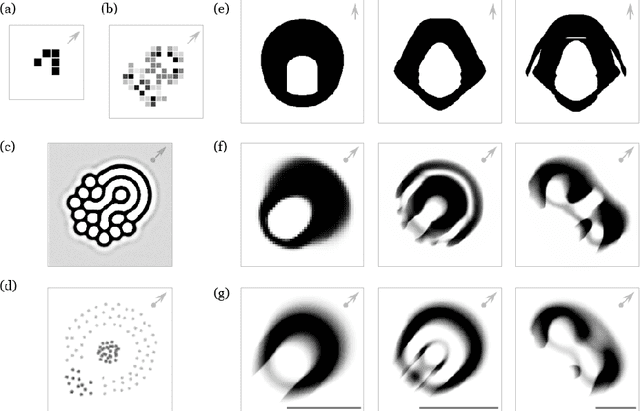

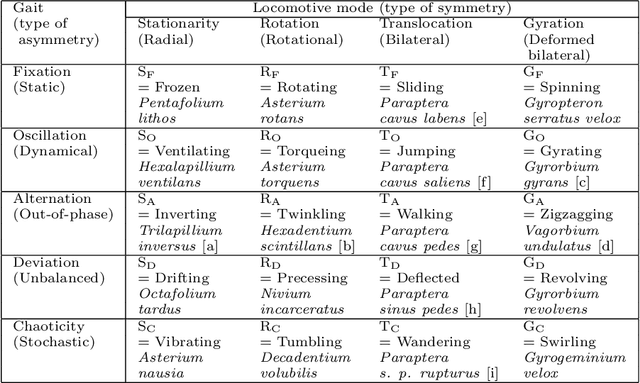
Abstract:We report a new model of artificial life called Lenia (from Latin lenis "smooth"), a two-dimensional cellular automaton with continuous space-time-state and generalized local rule. Computer simulations show that Lenia supports a great diversity of complex autonomous patterns or "lifeforms" bearing resemblance to real-world microscopic organisms. More than 400 species in 18 families have been identified, many discovered via interactive evolutionary computation. They differ from other cellular automata patterns in being geometric, metameric, fuzzy, resilient, adaptive, and rule-generic. We present basic observations of the model regarding the properties of space-time and basic settings. We provide a board survey of the lifeforms, categorize them into a hierarchical taxonomy, and map their distribution in the parameter hyperspace. We describe their morphological structures and behavioral dynamics, propose possible mechanisms of their self-propulsion, self-organization and plasticity. Finally, we discuss how the study of Lenia would be related to biology, artificial life, and artificial intelligence.
 Add to Chrome
Add to Chrome Add to Firefox
Add to Firefox Add to Edge
Add to Edge